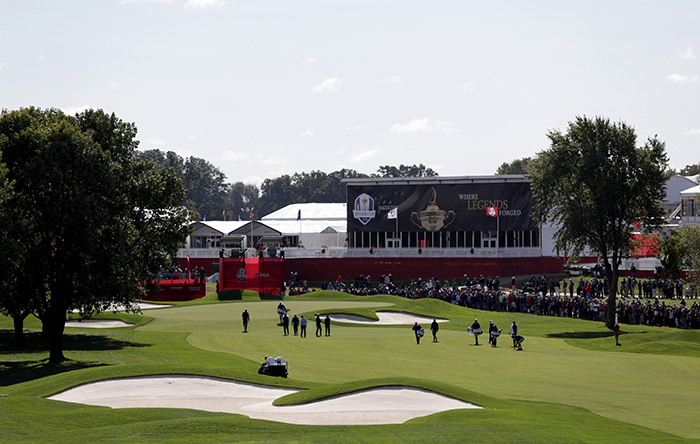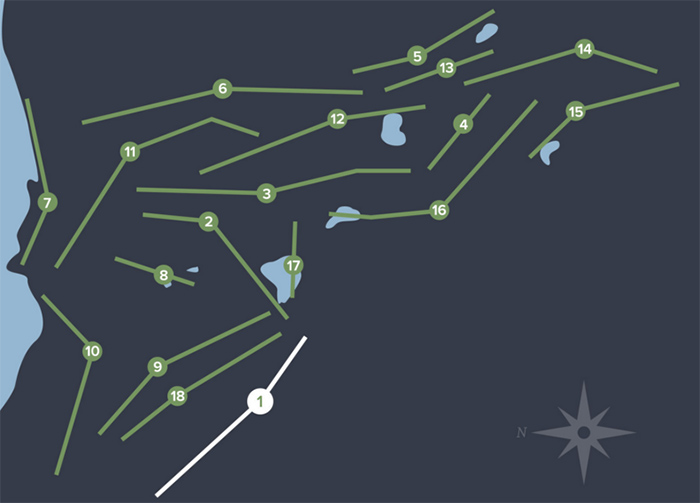Hazeltine National Golf Club is a par 72 course designed by Robert Trent Jones and opened in 1962. It’s a championship layout that plays to 6728 yards, and it’s most recent tournament was the 2009 PGA Championship. It has previously hosted the US Open, US Women’s Open, US Senior Open, and the US Amateur and Mid Amateur.
Hole 1
The first hole is typical of the challenges of Hazeltine. The drive zone is pinched by fairway bunkers, shots out of the rough will have difficulty holding the green, and the direction and strength of the wind will determine how aggressive a player can be. The green has distinct tiers, so an accurate approach shot can mean the difference between a birdie and a three putt.
Hole 2
This dogleg left provides an early birdie opportunity. A bold drive around the corner can leave a wedge to the green, but a relocated fairway bunker on the left side makes that a riskier strategy than it was for the 2002 PGA Championship. A more conservative tee shot now has to avoid the newly added bunkers on the right side of the fairway and will leave a challenging second if the prevailing wind is blowing hard at the player’s back and the hole is located behind the imposing bunkers that are on the front left of the green.
Hole 3
The first par 5 is a true three shot hole. The drive must avoid the penal bunkers on the left side of the fairway while missing the thick rough on the right. A safe second shot is played to a flat spot that leaves a short approach; more aggressive plays must hug the left side of the fairway or risk ending up well below the green in the right rough. The green is large, with a variety of difficult hole locations.
Hole 4
In the 1991 U.S. Open Championship, Fuzzy Zoeller and John Inman each aced the fourth hole. Surrounded by bunkers, the green features a shelf in the back that is difficult to hold and a flat area across the front of the green. In between is a relatively severe slope, so that a tee shot that is on the green but not close to the hole can easily lead to a bogey.
Hole 5
Billy Casper called this one of the greatest short par 4s in golf. It hasn’t changed much since he played it during the 1970 U.S. Open and the 1983 Senior Open, which he won. A new cross bunker short of the green enhances the risk/reward character of the hole. It seems easy on paper, but accuracy is essential, and the small green has hole locations that make birdies quite rare.
Hole 6
In 2002, Tiger Woods began his charge here when it played as the 15th hole at the PGA Championship. He made the first of four closing birdies although he fell one stroke short of victory. A new tee has added length to the hole, bringing bunkers back into play on the drive and the second shot, which should lead to higher scores, especially into the wind.
Hole 7
Johnny Miller said that this hole was “probably the hardest four-par I ever played.” The drive is over Hazeltine Lake, and must also be kept short of the creek on the left side of the fairway. The right rough is no bargain either, since the narrow, elevated green angles away and is difficult to hold. Hole locations along the right side bring the lake back into play. Anything can happen here.
Hole 8
This hole features a beautiful green site surrounded by bunkers and water. A large bowl in the front left portion of the green will capture any shots that are off the mark of the hole locations along the relatively narrow shelves on the right side and in the back. From there, three putts are common, making this green one of the most difficult on the golf course.
Hole 9
A new tee has lengthened this hole, forcing players to fit their drives between the bunkers left and right. The approach shots are played to a green with three distinct tiers, so accuracy is at a premium, especially if the hole is cut in the narrow front part of the green.
Hole 10
Accuracy off of the tee is critical on the opening hole of the back nine. The perfect drive is to the corner of the dogleg. From there, the hole plunges down the hill toward Hazeltine Lake. Back left hole locations are particularly difficult, since they bring the lake into play and approach shots that end up right of the ridge that bisects the green will leave two hard putts to make par.
Hole 11
This hole proved pivotal in the 2002 PGA Championship. Rich Beem played it perfectly, with a long drive to the middle of the fairway and a second shot that came to rest 8 feet from the hole. His eagle was the only one on the hole during the championship, and it propelled him to victory. Attempts to reach the green in two that come up short will now find a new bunker from which birdie will be an unlikely score.
Hole 12
Already thought to be one of the hardest holes on the course, a New tee has added fifty yards to it, making it truly daunting. The tee shot is relatively wide open and plays into the prevailing summer wind. The green is shallow and firm, making approach shots difficult. Other than a slick slope in the front of the green, most putts are relatively flat, but subtle breaks and the length of the hole will make birdies quite rare.
Hole 13
Following the difficult 12th hole, the hardest par 3 at Hazeltine provides no respite. A pond on the left, trees on the right, bunkers front and right, and difficult hole locations provide plenty of challenges. It is often a critical hole during championships, as it was for the 2006 U.S. Amateur. In seven match-play rounds, Richie Ramsay never made a bogey on the hole on his way to winning the Havemeyer Trophy.
Hole 14
A new teeing ground has added almost 50 yards to this hole, a favorite of the Hazeltine members. The longest hitters can try to fly the fairway bunkers, but the ball usually ends up in the left rough, the thickest on the course. The green is narrow and the deep bunkers in the front and on the sides are to be avoided at all costs. Because this hole is at the far end of the course, it doesn’t draw as many spectators as others, making it a great place to watch golf during a championship.
Hole 15
This hole has changed remarkably little since the course opened. Of prime importance is avoiding the woods on either side of the narrow fairway. Players who can hit driver into the fairway will be able to attack the hole locations on the long green that sits between bunkers on the right and a pond on the left. Those that lay up will face shots that must challenge the hazards or end up too far from the hole.
Hole 16
The shortest of the par fives at Hazeltine presents a variety of options. During the 2002 PGA Championship, most players went for green in two when the hole played at 543 yards. That can be a dicey strategy, since the pond on the left prevents easy access and the green can be hard to hold if it is downwind. A different course of action was taken by Justin Leonard; he laid up four times and made four birdies on the strength of his wedge play. New fairway bunkers have been added on the left side of the tee shot landing area making the tee shot a greater test than in the past.
Hole 17
Looking at the yardage, this might appear to be a relatively easy hole for the best players in the world. The small green encircled by water and sand is anything but easy. In championship after championship at Hazeltine, the winners have made par at this hole and moved on. Those who try to play it more aggressively, especially when the hole is cut in the narrow front portion of the green, are usually penalized.
Hole 18
The bunkers on boths sides of the fairway make this one of the most difficult driving holes on the course. Hitting uphill into a green that’s difficult to see means that players have to be precise in their yardage. Anything long or left of a hole cut in the depression on the right side will likely lead to a bogey.
The above information is from rydercup.com









